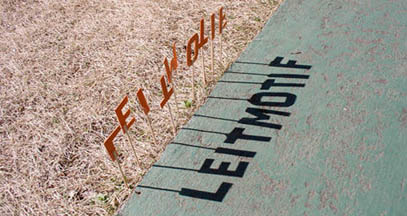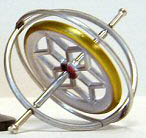Recurring Phrases
 At school, my German teacher was always talking about leitmotifs. Every time we began reading Thomas Mann’s Tonio Kröger she would get very enthused about its recurring images. References kept appearing to the old walnut tree in Tonio Kröger’s garden, as well as to his violin-playing, and to the blonde hair and blue eyes of his North German school friends. ‘A-hah!’ said my German teacher, das alte Walnussbaum! Die blaue Augen! These flashbacks helped to establish atmosphere and a sense of longing, she told us. As in music, they were repeated, melodic phrases, which suggested a certain character. Also, Leitmotif was a useful word to scatter about in exams. This should have prepared me for university, but when I went to study English Literature, I was startled by the way books were so rigorously pulled apart and dismembered in search of leitmotifs. It was like cracking walnuts. Tutors leapt on certain recurrent words and phrases with joy, as if they were proof of something. ‘Here is another reference to soup spoons! – this surely symbolises the narrators yearning for a return to domesticity, etc.’ But was it not just because they wanted to write a scene which involved soup spoons? I began to grow cynical. After a while, analysing a text started to feel like prising an oyster out of its shell – a slightly heartless and possibly overrated activity. Wasn’t the shell more beautiful to look at before it was pulled apart? It’s all very well to know, for instance, that there are lots of references to open windows and closed doors in To the Lighthouse, but I’m not sure it this knowledge increased my enjoyment of the book. Did Virginia Woolf really think, ‘I must put another closed door in this paragraph?’
At school, my German teacher was always talking about leitmotifs. Every time we began reading Thomas Mann’s Tonio Kröger she would get very enthused about its recurring images. References kept appearing to the old walnut tree in Tonio Kröger’s garden, as well as to his violin-playing, and to the blonde hair and blue eyes of his North German school friends. ‘A-hah!’ said my German teacher, das alte Walnussbaum! Die blaue Augen! These flashbacks helped to establish atmosphere and a sense of longing, she told us. As in music, they were repeated, melodic phrases, which suggested a certain character. Also, Leitmotif was a useful word to scatter about in exams. This should have prepared me for university, but when I went to study English Literature, I was startled by the way books were so rigorously pulled apart and dismembered in search of leitmotifs. It was like cracking walnuts. Tutors leapt on certain recurrent words and phrases with joy, as if they were proof of something. ‘Here is another reference to soup spoons! – this surely symbolises the narrators yearning for a return to domesticity, etc.’ But was it not just because they wanted to write a scene which involved soup spoons? I began to grow cynical. After a while, analysing a text started to feel like prising an oyster out of its shell – a slightly heartless and possibly overrated activity. Wasn’t the shell more beautiful to look at before it was pulled apart? It’s all very well to know, for instance, that there are lots of references to open windows and closed doors in To the Lighthouse, but I’m not sure it this knowledge increased my enjoyment of the book. Did Virginia Woolf really think, ‘I must put another closed door in this paragraph?’
 I’ve always liked wallowing in a book’s atmosphere rather than picking at the way it is created, even though I am a picky, word-worrying writer myself. It didn’t occur to me that my own stories had leitmotifs until somebody told me that they were full of pigeons. In fact birds in general, mainly the ones you find in cities – sparrows, seagulls, rooks and the occasional blackbird. It’s odd to discover that you have a subconscious fascination with avian life which only becomes plain once your thoughts have been printed and bound. (Although, I must admit that I do own a copy of Pigeons of the World, which I bought because I liked the title.)
I’ve always liked wallowing in a book’s atmosphere rather than picking at the way it is created, even though I am a picky, word-worrying writer myself. It didn’t occur to me that my own stories had leitmotifs until somebody told me that they were full of pigeons. In fact birds in general, mainly the ones you find in cities – sparrows, seagulls, rooks and the occasional blackbird. It’s odd to discover that you have a subconscious fascination with avian life which only becomes plain once your thoughts have been printed and bound. (Although, I must admit that I do own a copy of Pigeons of the World, which I bought because I liked the title.)
But people love to pin words down. Sometimes it seems very close to psychoanalysis. Abstract nouns are popular material for discussion – for instance, a reviewer once mentioned that I like the words dismally and suspicious, which would never have occurred to me.  Dismally and suspicious would not be words at the top of my Favourite Words list. Turquoise, maybe. Or gyroscope. Or twilight. I suppose it’s like hearing yourself on tape – you never realise how much you say ‘kind of’ or ‘you know’ or ‘I mean’ until you have tangible proof.
Dismally and suspicious would not be words at the top of my Favourite Words list. Turquoise, maybe. Or gyroscope. Or twilight. I suppose it’s like hearing yourself on tape – you never realise how much you say ‘kind of’ or ‘you know’ or ‘I mean’ until you have tangible proof.
It’s very easy to bash away at words – move them around, take them out, put them back in again – until you’ve forgotten what you started out with. It’s like drawing a delicate sketch and then worrying away at it for hours with a stick of charcoal in one hand and an eraser in the other. You can crouch over a paragraph, missing mealtimes, watching the room grow dark as you add commas and take them away again. For me, the happiest way to write is in a rush: when I don’t have enough time, when I have to be somewhere else. And the books on my shelf that I feel fondest of also tend to be the ones I read in a hurry, sometimes in one sitting. You can plod back over them and think, ‘I enjoyed this passage because
…’ but it’s much more fun just to enjoy and not wonder why. I can usually remember where I read my favourite, unanalysed books: Lorrie Moore’s Like Life in a cockroachy apartment in Argentina; Jean Rhys’s Good Morning, Midnight sitting on trains going to and from Glasgow; Muriel Spark’s A Far Cry From Kensington while I was in bed with a dismal bout of flu. I love books which can lift you out of a certain situation, but still imprint that situation on your memory; which can make you happy, even if they are not happy books. I like sentences that seem dashed-off. Most important for me is the feeling that the writer has captured an emotion that you thought was uniquely yours. I don’t know if it’s possible to interpret that – it would be like questioning why you are someone’s friend.
©Ruth Thomas
Ruth Thomas‘s first novel Things to Make and Mend is due from Faber in January 2007. She is the author of two short story collections, Sea Monster Tattoo (shortlisted for the John Llewellyn Rhys award and the Saltire Society First Book Award) and Dance Settee.

Comments